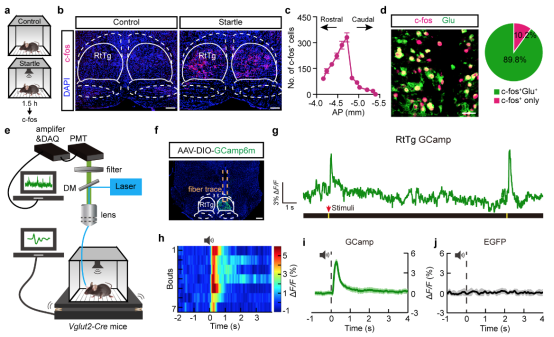Researchers Reveal How Startle Reflex Works
Do you enjoy watching horror movies? Do you often get startled by the monsters that suddenly appear? This kind of subconscious behavior in milliseconds induced by all mammals, including humans, in the face of sudden sound or tactile stimulation is called startle reflex.

The startle reflex, existing in the whole life cycle of all mammals, is a rapid, generalized motor response to a sudden, surprise stimulus. It protects our vulnerable parts, such as the eyes and the neck, by urgently contracting our body muscles, then gets us prepared for further defensive behavior, such as freezing, escape, avoidance, etc. The degree of startle reflex indicates the anxiety state of the body; abnormal startle reflex is closely related to Post-traumatic stress disorder (PTSD), Panic disorder (PD) and other mental diseases. Although the startle reflex is an important instinctive defensive behavior, the basic neural circuit controlling it still remains elusive.
Recently, a research team led by Prof. XIONG Wei from University of Science and Technology of China (USTC), revealed the important role that the neural circuit, the circuit from the cochlear nucleus (CN) to spinal motor neurons via caudal pontine reticular nucleus (PnC), played in regulating the behavior of startle reflex. The study was published in Nature Communications.
Mice were used as the models of the experiments. By performing Reticulotegmental nucleus (RtTg) c-fos staining and in vivo recording of the implantation of an optical fiber above the RtTg, researchers found that RtTg glutamatergic neurons in the brain stem were heavily activated during Acoustic startle reflex (ASR). Then through the approaches of optogenetic-activation and chemogenetic-inactivation, they found that specific activation of the RtTg glutamatergic neurons could instantly help researchers observe the bouncing performance as well as the electromyographic (EMG) activities in the neck and hindlimb of mice, which were typical startle reflex behaviors. On the contrary, RtTg inactivation specifically suppresses startle reflexes.
In the follow-up work, researchers made several projection tracing experiments. They found that RtTg glutamatergic neurons directly receive excitatory projections from CN, which is the first level receiving nucleus of sound information into the brain. Thus, findings of the previous experiments conducted by researchers were confirmed.
In order to confirm that the RtTg indeed innervates muscle-controlling Spinal motor neurons (MNs), researchers further performed rabies virus-based retrograde mono-transsynaptic tracing experiments. The results showed that RtTg glutamatergic neurons, after receiving the input from CN, directly project to MNs, and ultimately completed the control of neck and limb muscles.
This work identifies a RtTg-mediated neural circuit controlling the startle reflex for the first time, which deepens the current understanding of the neural mechanism of instinctive defensive behavior. It also provides a new direction for further researches on the abnormal startle reflex that occurs in PTD, PD and other mental diseases.
(Written by WANG Xiao, edited by LI Xiaoxi, USTC News Center)
Back
